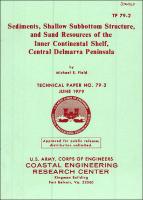Please use this identifier to cite or link to this item:
https://hdl.handle.net/11681/22183Full metadata record
| DC Field | Value | Language |
|---|---|---|
| dc.contributor.author | Field, Michael E. | - |
| dc.date.accessioned | 2017-05-01T15:38:21Z | - |
| dc.date.available | 2017-05-01T15:38:21Z | - |
| dc.date.issued | 1979-06 | - |
| dc.identifier.govdoc | TP 79-2 | - |
| dc.identifier.uri | http://hdl.handle.net/11681/22183 | - |
| dc.description | Technical Paper | en_US |
| dc.description.abstract | Abstract: A data base consisting of 880, 180, and 35 kilometers (475, 97, and 19 nautical miles) each of high-resolution seismic reflection, bathymetric, and side-scan sonar profilings was obtained in 1970 and 1974, along with 71 vibratory cores and 3 onshore borings. These data were analyzed to assess the resource potential of sand suitable for use in beach restoration and to establish the Quaternary evolutionary framework of the northern Delmarva inner shelf. Shallow subsurface strata consist of gently dipping Neogene sedimentary beds that conform to the gradient and direction of the Atlantic Coastal Plain and display no evidence of tectonic deformation. Eleven major acoustic surfaces, including the presumed Tertiary-Quaternary nonconformity at about -30.5 to -61 meters (-100 to -200 feet), are present within the upper 122 meters (400 feet) of the shelf subbottom. Buried channels are common to the sea floor of the entire region; in the Delaware Bay entrance, most channels are cut to 46 meters (150 feet) below sea level and are filled laterally from both the New Jersey and Delaware shelves. Many small channels on the Maryland shelf are aligned with existing onshore drainage or historical inlet sites. The upper 6 meters (20 feet) of the inner shelf consists of terrigenous sands and silts derived from the adjacent Coastal Plain and Piedmont Province. Environments of deposition represented on the shallow shelf are: modern marine, back barrier, lagoonal, and fluvial. Gray-brown, fine to coarse, well-sorted quartz sand is the dominant lithology on the surface and decreases in relative abundance with depth. The shoal sands uncomfortably overlie poorly sorted fine sands and muds remnant from Holocene back-barrier and lagoonal deposition, which are periodically exposed and eroded on the sea floor. Linear shoals are a dominant topographic feature of the U.S. mid-Atlantic shelf and off the Maryland shelf. They have a high potential as an offshore source of sand for use in beach restoration. Individual shoals typically contain between 15 and 54 million cubic meters (20 and 70 million yards) of fine to coarse, well sorted to moderately sorted quartz sand. | en_US |
| dc.format.extent | 126 pages / 26.32 Mb | - |
| dc.format.medium | PDF/A | - |
| dc.language.iso | en_US | en_US |
| dc.publisher | Coastal Engineering Research Center (U.S.) | en_US |
| dc.relation.ispartofseries | Technical Paper (Coastal Engineering Research Center (U.S.)) ; no. TP 79-2 | - |
| dc.rights | Approved for public release; distribution is unlimited. | - |
| dc.source | This Digital Resource was created from scans of the Print Resource. | - |
| dc.subject | Continental shelf--Delmarva Peninsula | en_US |
| dc.subject | Geomorphology--Delmarva Peninsula | en_US |
| dc.title | Sediments, shallow subbottom structure, and sand resources of the inner continental shelf, central Delmarva Peninsula | en_US |
| dc.type | Report | - |
| Appears in Collections: | Technical Paper | |
Files in This Item:
| File | Description | Size | Format | |
|---|---|---|---|---|
| TP 79-2.pdf | 26.96 MB | Adobe PDF |  View/Open |